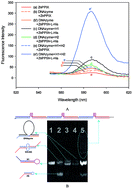Hybridization chain reaction based DNAzyme fluorescent sensor for l-histidine assay
Abstract
A hybridization chain reaction (HCR)-based DNAzyme fluorescent sensor is demonstrated for L-histidine (L-His) assays. L-His molecules initiate catalytic reactions to hydrolytic cleavage of the substrate strands of DNAzyme. The cleaved substrates open hairpin strands as primers, and thus trigger a cascade of hybridization events that yield a chain of G-quadruplex, which binds with porphyrin molecules to enhance its fluorescent intensity as a versatile signaling reporter. The linear range is from 5.0 × 10−9 mol L−1 to 5.0 × 10−6 mol L−1. The method reveals good recovery rates from 99.8% to 103% in real samples. In our work, the target enables the effective conversion of DNAzyme to active HCR. HCR amplified the oligonucleotide products, improving the signaling to the extent of the detection limit. Our work provides a rapid, accurate and enzyme-free means of target quantification. This approach is expected to extend the fabrication of target cleaving DNA biosensor systems for biological entities at room temperature.



 Please wait while we load your content...
Please wait while we load your content...